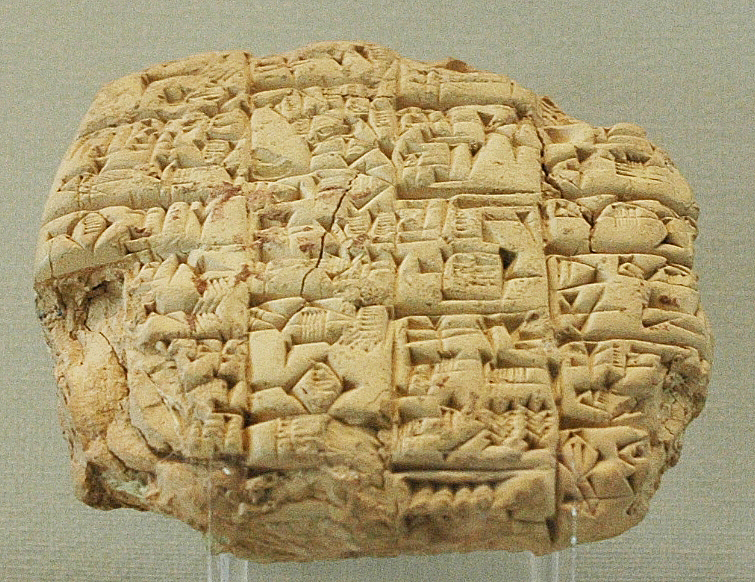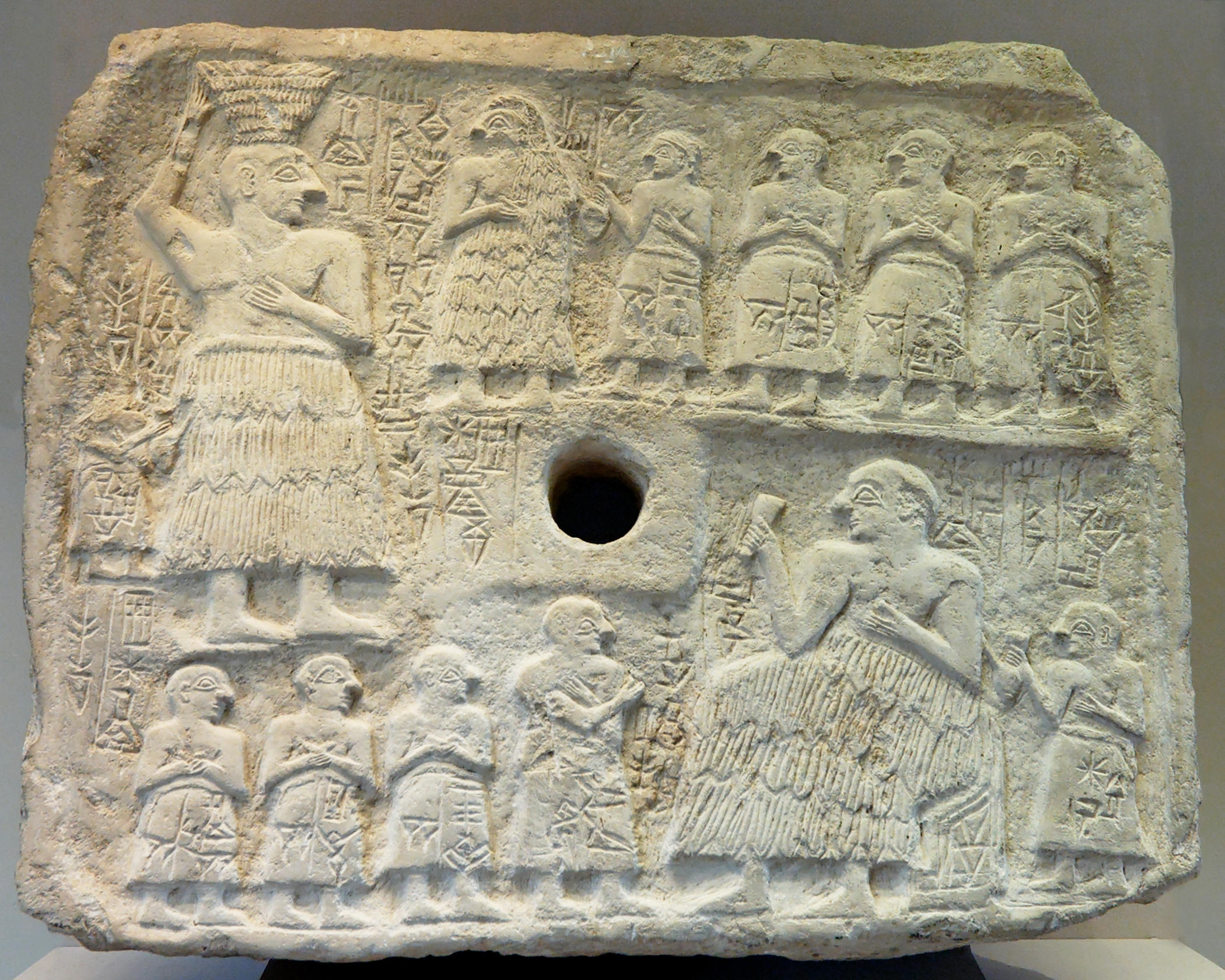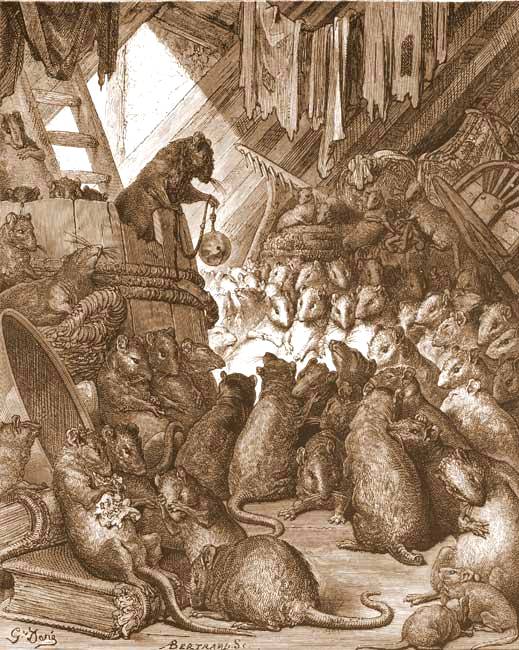|
Ištaran
Ištaran (Ishtaran; ) was a Mesopotamian god who was the tutelary deity of the city of Der, a city-state located east of the Tigris, in the proximity of the borders of Elam. It is known that he was a divine judge, and his position in the Mesopotamian pantheon was most likely high, but much about his character remains uncertain. He was associated with snakes, especially with the snake god Nirah, and it is possible that he could be depicted in a partially or fully serpentine form himself. He is first attested in the Early Dynastic period in royal inscriptions and theophoric names. He appears in sources from the reign of many later dynasties as well. When Der attained independence after the Ur III period, local rulers were considered representatives of Ištaran. In later times, he retained his position in Der, and multiple times his statue was carried away by Assyrians to secure the loyalty of the population of the city. Name Ištaran's name could be written in cuneiform as dKA.DI ... [...More Info...] [...Related Items...] OR: [Wikipedia] [Google] [Baidu] [Amazon] |
Mesopotamian Pantheon
Deities in ancient Mesopotamia were almost exclusively Anthropomorphism, anthropomorphic. They were thought to possess extraordinary powers and were often envisioned as being of tremendous physical size. The deities typically wore ''melam'', an ambiguous substance which "covered them in terrifying splendor" and which could also be worn by heroes, kings, giants, and even demons. The effect that seeing a deity's ''melam'' has on a human is described as ''ni'', a word for the "Paresthesia, physical creeping of the flesh". Both the Sumerian language, Sumerian and Akkadian languages contain many words to express the sensation of ''ni'', including the word ''puluhtu'', meaning "fear". Deities were almost always depicted wearing horned caps, consisting of up to seven superimposed pairs of ox-horns. They were also sometimes depicted wearing clothes with elaborate decorative gold and silver ornaments sewn into them. The ancient Mesopotamians believed that their deities lived in Heaven, ... [...More Info...] [...Related Items...] OR: [Wikipedia] [Google] [Baidu] [Amazon] |
Nirah
Nirah was a Mesopotamian god who served as the messenger (''šipru'') of Ištaran, the god of Der. He was depicted in the form of a snake. Name and character The name Nirah means "little snake" in Sumerian. It could be written with the logogram dMUŠ (), as already attested in third millennium BCE texts from Ebla. However, this logogram could also designate Ištaran, Ninazu, the tutelary god of Susa, Inshushinak, the tutelary god of Eshnunna, Tishpak, and the primordial river deity Irḫan. With a different determinative, mulMUŠ, it referred to the constellation Hydra. Syllabic spellings are also attested, for example ''Ne-ra-aḫ'', ''Ni-laḫ5'', ''Ni-ra-aḫ'' and ''Ni-ra-ḫu''. Nirah was at times confused with Irḫan, originally the name of the western branch of the Euphrates, personified as a deity. The early history of these two deities is not fully understood, and it has been proposed that their names were cognate with each other, though the view that they s ... [...More Info...] [...Related Items...] OR: [Wikipedia] [Google] [Baidu] [Amazon] |
Tishpak
Tishpak (Tišpak) was a Mesopotamian god associated with the ancient city Eshnunna and its sphere of influence, located in the Diyala area of Iraq. He was primarily a war deity, but he was also associated with snakes, including the mythical mushussu and bashmu, and with kingship. Tishpak was of neither Sumerian nor Akkadian origin and displaced Eshnunna's original tutelary god, Ninazu. Their iconography and character were similar, though they were not formally regarded as identical in most Mesopotamian sources. Origin It is commonly assumed that initially the tutelary deity of Eshnunna was Ninazu, worshiped in the temple Esikil. From the Sargonic period onward, Tishpak competed with Ninazu in that location, and the latter finally ceased to be mentioned in documents from it after Hammurabi's conquest. While similar in character, Ninazu and Tishpak were not fully conflated, and unlike Inanna and Ishtar or Enki and Ea were kept apart in god lists. It is generally agreed by sc ... [...More Info...] [...Related Items...] OR: [Wikipedia] [Google] [Baidu] [Amazon] |
Irḫan
Irḫan was a Mesopotamian god who personified the western branch of the Euphrates, which in the first millennium BCE became its main course. The name could also refer to the river itself. The woirship of Irḫan is sparsely attested, and many aspects of his character as a deity are uncertain. Two topics which continue to be a subject of debate among experts are his association or confusion with the snake god Nirah, and his proposed cosmogonic role. Name Irḫan was the Sumerian name of the western branch of the Euphrates. In Akkadian it was called Araḫtu. These names are cognates, and most likely both were derived from the Semitic root rḫ'', "to go on route." Araḫtu grew in importance in the first millennium BCE, because the eastern branch flowing through cities such as Kish and Nippur, which was formerly the main course, became difficult to navigate. As a result, the name Araḫtu started to be used interchangeably with Purattu. The name could be written both syllabic ... [...More Info...] [...Related Items...] OR: [Wikipedia] [Google] [Baidu] [Amazon] |
Mandanu
Mandanu or Madanu was a Mesopotamian god associated with justice. It has been proposed that he was a divine representation of places of judgment. He is known chiefly from sources postdating the Old Babylonian period, and older documents, such as the Nippur god list, do not mention him. He was worshiped mostly in the north of Babylonia, especially in the city of Babylon itself. He was regarded as one of the deities belonging to the circle of Marduk. Character Mandanu's name was written as either '' dma-da-nu'' or ''dman-da-nu'', with the latter spelling considered a secondary development. It is most likely derived from the word ''diānum'', "to judge." The logographic writing dDI.KU5 is also attested, though the same signs could also be read as the theonym Ištaran. His primary role was that of a divine judge. Manfred Krebernik proposes he might have originally been understood as the deification of places of judgment. According to the god list ''An = Anum'' and the incantation ser ... [...More Info...] [...Related Items...] OR: [Wikipedia] [Google] [Baidu] [Amazon] |
Sumerian Language
Sumerian ) was the language of ancient Sumer. It is one of the List of languages by first written account, oldest attested languages, dating back to at least 2900 BC. It is a local language isolate that was spoken in ancient Mesopotamia, in the area that is modern-day Iraq, Iraq. Akkadian language, Akkadian, a Semitic languages, Semitic language, gradually replaced Sumerian as the primary spoken language in the area (the exact date is debated), but Sumerian continued to be used as a sacred, ceremonial, literary, and scientific language in Akkadian-speaking Mesopotamian states, such as Assyria and Babylonia, until the 1st century AD. Thereafter, it seems to have fallen into obscurity until the 19th century, when Assyriologists began Decipherment, deciphering the cuneiform inscriptions and excavated tablets that had been left by its speakers. In spite of its extinction, Sumerian exerted a significant influence on the languages of the area. The Cuneiform, cuneiform script, original ... [...More Info...] [...Related Items...] OR: [Wikipedia] [Google] [Baidu] [Amazon] |
Der (Sumer)
Der (Sumerian language, Sumerian: 𒌷𒂦𒀭𒆠 ''uruBAD3.ANki''; Akkadian language, Akkadian: 𒌷𒂦𒀭𒆠 ''uruBAD3.ANki'' or ''urude-e-ru(ki)'') was a Sumerian city-state at the site of modern Tell Aqar near Badra, Iraq, al-Badra in Iraq's Wasit Governorate. It was east of the Tigris River on the border between Sumer and Elam. At one time it was thought that it might have been ancient Durum (Sumerian language, Sumerian: ''uruBAD3ki'') but more recent scholarship has rebutted that. The principal god of Der was Ištaran. In the 1st millennium BC, he was also referred to as ''Anu rabû'' ("''Great Anu''") in Akkadian. The name of his temple at Der was Edimgalkalama. History Early Bronze Der was occupied from the Early Dynastic Period (Mesopotamia), Early Dynastic period through Neo-Assyrian times. The local deity of the city was named Ishtaran, represented on Earth by his minister, the snake god Nirah. Ur III period In the late 3rd millennium, during the reign of Sulgi ... [...More Info...] [...Related Items...] OR: [Wikipedia] [Google] [Baidu] [Amazon] |
Emesal
Sumerian was the language of ancient Sumer. It is one of the oldest attested languages, dating back to at least 2900 BC. It is a local language isolate that was spoken in ancient Mesopotamia, in the area that is modern-day Iraq. Akkadian, a Semitic language, gradually replaced Sumerian as the primary spoken language in the area (the exact date is debated), but Sumerian continued to be used as a sacred, ceremonial, literary, and scientific language in Akkadian-speaking Mesopotamian states, such as Assyria and Babylonia, until the 1st century AD. Thereafter, it seems to have fallen into obscurity until the 19th century, when Assyriologists began deciphering the cuneiform inscriptions and excavated tablets that had been left by its speakers. In spite of its extinction, Sumerian exerted a significant influence on the languages of the area. The cuneiform script, originally used for Sumerian, was widely adopted by numerous regional languages such as Akkadian, Elamite, Eblaite, ... [...More Info...] [...Related Items...] OR: [Wikipedia] [Google] [Baidu] [Amazon] |
Lagash
Lagash (; cuneiform: LAGAŠKI; Sumerian language, Sumerian: ''Lagaš'') was an ancient city-state located northwest of the junction of the Euphrates and Tigris rivers and east of Uruk, about east of the modern town of Al-Shatrah, Iraq. Lagash (modern Al-Hiba in Dhi Qar Governorate) was one of the oldest cities of the Ancient Near East. The ancient site of Nina (Tell Zurghul) is around away and marks the southern limit of the state. Nearby Girsu (modern Telloh), about northwest of Lagash, was the religious center of the Lagash state. The Lagash state's main temple was the E-ninnu at Girsu, dedicated to the god Ningirsu. The Lagash state incorporated the ancient cities of Lagash, Girsu, Nina. History Though some Uruk period pottery shards were found in a surface survey, significant occupation at the site of Lagash began early in the 3rd Millennium BC, in the Early Dynastic Period (Mesopotamia), Early Dynastic I period (c. 2900–2600 BC), surface surveys and excavations show tha ... [...More Info...] [...Related Items...] OR: [Wikipedia] [Google] [Baidu] [Amazon] |
Gudea
Gudea ( Sumerian: , ''Gu3-de2-a''; died 2124 BC) was a Sumerian ruler ('' ensi'') of the state of Lagash in Southern Mesopotamia, who ruled –2060 BC ( short chronology) or 2144–2124 BC ( middle chronology). He probably did not come from the city, but had married Ninalla, daughter of the ruler Ur-Baba (2164–2144 BC) of Lagash, thus gaining entrance to the royal house of Lagash. He was succeeded by his son Ur-Ningirsu II. Gudea ruled at a time when the center of Sumer was still ruled by the Gutian dynasty, and when the Akkadian king Ishtup-Ilum ruled to the north in Mari. Under Gudea, Lagash had a golden age, and seemed to enjoy a high level of independence from the Gutians, a language isolate speaking people who had arrived from regions to the northeast of Mesopotamia. Inscriptions Gudea chose the title of ''énsi'' (town-king or governor), not the more exalted ( Akkadian ''šarrum''). Gudea did not style himself "god of Lagash" as he was not deified during his own ... [...More Info...] [...Related Items...] OR: [Wikipedia] [Google] [Baidu] [Amazon] |
Proverbial
A proverb (from ) or an adage is a simple, traditional saying that expresses a perceived truth based on common sense or experience. Proverbs are often metaphorical and are an example of formulaic speech, formulaic language. A proverbial phrase or a proverbial expression is a type of a conventional saying similar to proverbs and transmitted by oral tradition. The difference is that a proverb is a fixed expression, while a proverbial phrase permits alterations to fit the grammar of the context. Collectively, they form a folklore genre, genre of folklore. Some proverbs exist in more than one language because people borrow them from languages and cultures with which they are in contact. In the West, the Bible (including, but not limited to the Book of Proverbs) and medieval Latin (aided by the work of Erasmus) have played a considerable role in distributing proverbs. Not all Biblical proverbs, however, were distributed to the same extent: one scholar has gathered evidence to show th ... [...More Info...] [...Related Items...] OR: [Wikipedia] [Google] [Baidu] [Amazon] |




